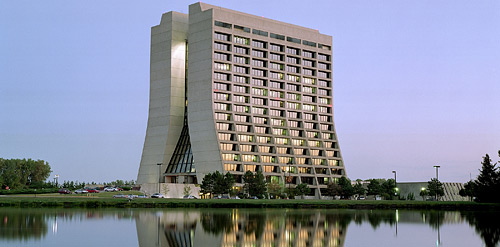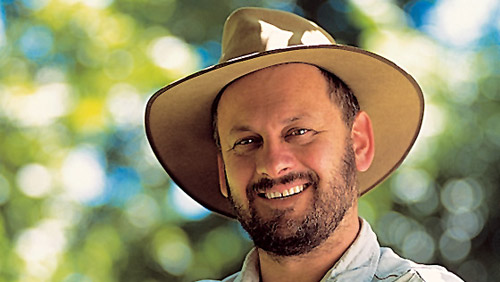
The Robert Rathbun Wilson Hall on the Fermilab campus. (photo credit: Fermilab)
Shermer in Chicago this Friday…
Fermi National Accelerator Laboratory Lectures
with Dr. Michael Shermer
Friday, April 7th, Fermilab, Batavia, Illinois
4 pm – The Science of Good & Evil
8 pm – Why People Believe Weird Things
The afternoon lecture, originally scheduled to be a small lecture for the scientific staff, has now been opened to the general public and moved to the larger 830 seat Ramsey Auditorium in Wilson Hall. The afternoon lecture is free of charge and seats are still available.
The evening lecture has sold out at 830 people, but a video feed into an adjacent hall will be provided. Seats are still available in the adjacent hall.
For further information, contact:
Janet Mackay: [email protected]visit: www.fnal.gov/culture/Lectures/
or call: 630-840-2787

A baby chimpanzee in a wildlife shelter in Cameroon, West Africa. (Photo by Hagit Berkovich.)
“Don’t be a Chimp”
Shermer on SETI Radio
On March 22nd, 2006, Michael Shermer appeared on the SETI Institute’s weekly science radio program, Are We Alone? In this show, Shermer shares what he learned about Darwin after having retraced his steps on a journey through the Galapagos Islands.
Are We Alone? is available via podcast as SETI: Science & Skepticism using podcast software such as iTunes. SETI Radio is also available via streaming MP3 audio.
In this week’s eSkeptic, Michael Shermer reports on the findings of a recent scientific study that tested the efficacy of intercessory prayer.

Prayer & Healing
The Verdict is in and the Results are Null
by Michael Shermer
In a long-awaited comprehensive scientific study on the effects of intercessory prayer on the health and recovery of 1,802 patients undergoing coronary bypass surgery in six different hospitals, prayers offered by strangers had no effect. In fact, contrary to common belief, patients who knew they were being prayed for had a higher rate of post-operative complications such as abnormal heart rhythms, possibly the result of anxiety caused by learning that they were being prayed for and thus their condition was more serious than anticipated.
The study, which cost $2.4 million (most of which came from the John Templeton Foundation), was begun almost a decade ago and was directed by Harvard University Medical School cardiologist Dr. Herbert Benson and published in The American Heart Journal, was by far the most rigorous and comprehensive study on the effects of intercessory prayer on the health and recovery of patients ever conducted. In addition to the numerous methodological flaws in the previous research corrected for in the Benson study, Dr. Richard Sloan, a professor of behavioral medicine at Columbia and author of the forthcoming book, Blind Faith: The Unholy Alliance of Religion and Medicine, explained:
The problem with studying religion scientifically is that you do violence to the phenomenon by reducing it to basic elements that can be quantified, and that makes for bad science and bad religion.
The 1,802 patients were divided into three groups, two of which were prayed for by members of three congregations: St. Paul’s Monastery in St. Paul, Minnesota; the Community of Teresian Carmelites in Worcester, Massachusetts; and Silent Unity, a Missouri prayer ministry near Kansas City. The prayers were allowed to pray in their own manner, but they were instructed to include the following phrase in their prayers: “for a successful surgery with a quick, healthy recovery and no complications.” Prayers began the night before the surgery and continued daily for two weeks after. Half the prayer-recipient patients were told that they were being prayed for while the other half were told that they might or might not receive prayers. The researchers monitored the patients for 30 days after the operations.
Results showed no statistically significant differences between the prayed-for and non-prayed-for groups. Although the following findings were not statistically significant, 59% of patients who knew that they were being prayed for suffered complications, compared with 51% of those who were uncertain whether they were being prayed for or not; and 18% in the uninformed prayer group suffered major complications such as heart attack or stroke, compared with 13% in the group that received no prayers.
This study is particularly significant because Herbert Benson has long been sympathetic to the possibility that intercessory prayer can positively influence the health of patients. His team’s rigorous methodologies overcame the numerous flaws that called into question previously published studies. The most commonly cited study in support of the connection between prayer and healing is:
Randolph C. Byrd, “Positive Therapeutic Effects of Intercessory Prayer in a Coronary Care Unit Population,” Southern Medical Journal 81 (1998): 826–829.
The two best studies on the methodological problems with prayer and healing include the following:
Richard Sloan, E. Bagiella, and T. Powell. 1999. “Religion, Spirituality, and Medicine,” The Lancet. Feb. 20, Vol. 353: 664–667; and,
John T. Chibnall, Joseph M. Jeral, Michael Cerullo. 2001. “Experiments on Distant Intercessory Prayer.” Archives of Internal Medicine, Nov. 26, Vol. 161: 2529–2536. www.archinternmed.com
The most significant flaws in all such studies include the following:
Fraud
In 2001, the Journal of Reproductive Medicine published a study by three Columbia University researchers claiming that prayer for women undergoing in-vitro fertilization resulted in a pregnancy rate of 50%, double that of women who did not receive prayer. Media coverage was extensive. ABC News medical correspondent Dr. Timothy Johnson, for example, reported, “A new study on the power of prayer over pregnancy reports surprising results; but many physicians remain skeptical.” One of those skeptics was a University of California Clinical Professor of Gynecology and Obstetrics named Bruce Flamm, who not only found numerous methodological errors in the experiment, but also discovered that one of the study’s authors, Daniel Wirth (AKA “John Wayne Truelove”), is not an M.D., but an M.S. in parapsychology who has since been indicted on felony charges for mail fraud and theft, for which he pled guilty. The other two authors have refused comment, and after three years of inquires from Flamm the journal removed the study from its website and Columbia University launched an investigation.
Lack of Controls
Many of these studies failed to control for such intervening variables as age, sex, education, ethnicity, socioeconomic status, marital standing, degree of religiosity, and the fact that most religions have sanctions against such insalubrious behaviors as sexual promiscuity, alcohol and drug abuse, and smoking. When such variables are controlled for, the formerly significant results disappear. One study on recovery from hip surgery in elderly women failed to control for age; another study on church attendance and illness recovery did not consider that people in poorer health are less likely to attend church; a related study failed to control for levels of exercise.
Outcome Differences
In one of the most highly publicized studies of cardiac patients prayed for by born-again Christians, 29 outcome variables were measured but on only six did the prayed-for group show improvement. In related studies, different outcome measures were significant. To be meaningful, the same measures need to be significant across studies, because if enough outcomes are measured some will show significant correlations by chance.
File-Drawer Problem
In several studies on the relationship between religiosity and mortality (religious people allegedly live longer), a number of religious variables were used, but only those with significant correlations were reported. Meanwhile, other studies using the same religiosity variables found different correlations and, of course, only reported those. The rest were filed away in the drawer of non-significant findings. When all variables are factored in together, religiosity and mortality show no relationship.
Operational Definitions
When experimenting on the effects of prayer, what, precisely, is being studied? For example, what type of prayer is being employed? (Are Christian, Jewish, Muslim, Buddhist, Wiccan, and Shaman prayers equal?) Who or what is being prayed to? (Are God, Jesus, and a universal life force equivalent?) What is the length and frequency of the prayer? (Are two 10-minute prayers equal to one 20-minute prayer?) How many people are praying and does their status in the religion matter? (Is one priestly prayer identical to ten parishioner prayers?) Most prayer studies either lack such operational definitions, or there is no consistency across studies in such definitions.
Theological Implications
The ultimate fallacy of all such studies is theological. If God is omniscient and omnipotent, He should not need to be reminded or inveigled that someone needs healing. Scientific prayer makes God a celestial lab rat, leading to bad science and worse religion.

lecture reminder…
The Weather Makers
How Humans are Changing the Climate
& What it Means for Life on Earth
with Dr. Tim Flannery
Sunday, April 9th, 2 pm
Baxter Lecture Hall, Caltech
Dr. Flannery outlines the history of climate change, how it will unfold over the next century, and what we can do to prevent a cataclysmic future, including what every one of us can do right now to reduce deadly CO2 emissions by as much as 70%.









